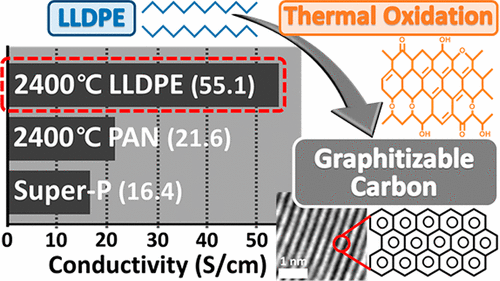当前位置:
X-MOL 学术
›
Chem. Mater.
›
论文详情
Our official English website, www.x-mol.net, welcomes your feedback! (Note: you will need to create a separate account there.)
High Performance Graphitic Carbon from Waste Polyethylene: Thermal Oxidation as a Stabilization Pathway Revisited
Chemistry of Materials ( IF 8.6 ) Pub Date : 2017-10-31 00:00:00 , DOI: 10.1021/acs.chemmater.7b03737 Dalsu Choi 1 , Dawon Jang 1, 2 , Han-Ik Joh 3 , Elsa Reichmanis 4 , Sungho Lee 1, 2
Chemistry of Materials ( IF 8.6 ) Pub Date : 2017-10-31 00:00:00 , DOI: 10.1021/acs.chemmater.7b03737 Dalsu Choi 1 , Dawon Jang 1, 2 , Han-Ik Joh 3 , Elsa Reichmanis 4 , Sungho Lee 1, 2
Affiliation

|
In this study, for the first time, thermal oxidation, which has only been considered as a degradation pathway for plastics, served as a simple and effective pretreatment protocol to modulate the chemical structure of linear low density polyethylene (LLDPE) for successful conversion of “noncarbonizable” LLDPE into an ordered carbon. More importantly, LLDPE based carbon could be graphitized into a highly ordered graphitic carbon with exceptional electrical performance exceeding that of Super-P, a pricey reference conductive agent for lithium ion battery fabrication. Upon thermal oxidative pretreatment, inherently noncarbonizable LLDPE was successfully transformed into an ordered carbon through heat treatment with a high conversion yield reaching 50%, a yield comparable to that obtained from polyacrylonitrile (PAN), a reference polymeric precursor. Systematic interrogation of the chemical structural evolution using X-ray diffraction, Raman, and dynamic scanning calorimetry (DSC) analysis, confirmed that an oxidation reaction occurred around 330 °C, which initiated transformation of aliphatic chains into cyclized ladder structures that allowed successful carbonization of LLDPE with high carbon yield. The thermally oxidized LLDPE evolved into a highly graphitic carbon that exhibited superior degree of ordering and electrical performance over a graphitized PAN counterpart. Finally, LLDPE waste, such as cling wrap and poly gloves was also successfully converted into an ordered carbon comparable to that obtained from the as-produced LLDPE precursor, suggesting opportunities associated with “upcylcing” of waste products. Thus, the proposed protocol represents an effective, potentially low-cost, and sustainable pathway providing for an exceptionally high quality conductive agent applicable in energy storage and flexible, printed electronics.
中文翻译:

废聚乙烯中的高性能石墨碳:热氧化作为稳定途径的再研究
在这项研究中,首次将热氧化(仅被视为塑料的降解途径)用作简单有效的预处理方案,以调节线性低密度聚乙烯(LLDPE)的化学结构,从而成功地将“不可碳化” LLDPE转化为有序碳。更重要的是,基于LLDPE的碳可以被石墨化为高度有序的石墨碳,其卓越的电性能超过Super-P(一种昂贵的锂离子电池制造参考导电剂)。经过热氧化预处理后,固有的不可碳化的LLDPE通过热处理成功转化为有序碳,转化率高达50%,可与参考聚丙烯前体聚丙烯腈(PAN)的产率相媲美。使用X射线衍射,拉曼光谱和动态扫描量热法(DSC)对系统的化学结构演变进行系统的询问,证实了在330°C左右发生了氧化反应,这引发了脂肪族链向环化梯形结构的转化,从而使碳化物成功碳化。具有高碳收率的LLDPE。热氧化的LLDPE演变成高度石墨化的碳,与石墨化的PAN对应物相比,其表现出更高的有序度和电性能。最后,LLDPE废料(如保鲜膜和聚手套)也成功转化为有序碳,与从生产的LLDPE前体中获得的碳相当,这暗示了与废品“升级”相关的机会。因此,建议的协议代表了一种有效的,潜在的低成本,
更新日期:2017-10-31
中文翻译:

废聚乙烯中的高性能石墨碳:热氧化作为稳定途径的再研究
在这项研究中,首次将热氧化(仅被视为塑料的降解途径)用作简单有效的预处理方案,以调节线性低密度聚乙烯(LLDPE)的化学结构,从而成功地将“不可碳化” LLDPE转化为有序碳。更重要的是,基于LLDPE的碳可以被石墨化为高度有序的石墨碳,其卓越的电性能超过Super-P(一种昂贵的锂离子电池制造参考导电剂)。经过热氧化预处理后,固有的不可碳化的LLDPE通过热处理成功转化为有序碳,转化率高达50%,可与参考聚丙烯前体聚丙烯腈(PAN)的产率相媲美。使用X射线衍射,拉曼光谱和动态扫描量热法(DSC)对系统的化学结构演变进行系统的询问,证实了在330°C左右发生了氧化反应,这引发了脂肪族链向环化梯形结构的转化,从而使碳化物成功碳化。具有高碳收率的LLDPE。热氧化的LLDPE演变成高度石墨化的碳,与石墨化的PAN对应物相比,其表现出更高的有序度和电性能。最后,LLDPE废料(如保鲜膜和聚手套)也成功转化为有序碳,与从生产的LLDPE前体中获得的碳相当,这暗示了与废品“升级”相关的机会。因此,建议的协议代表了一种有效的,潜在的低成本,



























 京公网安备 11010802027423号
京公网安备 11010802027423号